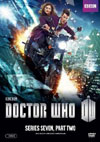DVD Extras for this story on the 15-episode box sets include:
Claiming SpacePerhaps what this story does best is to keep its audience on their toes. It never really falls into any discernable predictable pattern where you can say with absolute certainty that you know what's going to happen. At times, you may think you can predict the outcome, but then it makes another left turn and twists down yet another avenue.Of course, one of the great keys to maintaining unpredictability is to make sure we're not threatening the Earth. Writer Neil Gaiman is smart enough to take us to a whole new planet called Hedgewick's World and threaten that instead. In fact, the dialogue often highlights the fact that we don't know how the threat will be dealt with and whether or not it will cost the planet, and this is an effective question that remains in play throughout the episode. For my tastes Hedgewick's World could have done without the American flag on a recreation of Earth and its moon. We never really learn for sure whether or not this population is primarily of Earth descent or not, but even if not, and this was just an odd bit of our culture that they absorbed from us, you'd think we could have randomly landed in an exhibit drawn from some other race's culture. The real set-up for this show is in a nice little scene at the end of the previous story. This episode begins in full swing with the TARDIS materializing properly (thank you!) and the Doctor and Jenna coming out with Angie and Artie in tow. This is a nice quartet which successfully recreates the atmosphere of family exploration that was at the heart of the original series when it started in 1963, and the early Peter Davison era was really the only time it was recreated outside of the 1960's. Until now. The early scenes in this story hit a really nice tone, and I would certainly welcome more of this in future. Watching this episode cold, the presence of Cybermen seems to be a red herring at first. As was the case in "Dalek" (story no. 165) which revealed a Cyberman's head before the title sequence, or even the one at Demon's Run (story no. 223) or "The Pandorica Opens" (story no. 217) which featured cyber-cameos, this story easily seems like it could really be all about something else that hasn't yet been revealed. Thusly, Gaiman keeps the audience on their toes. In the end though, this turns out to be the most solid and substantial Cyberman story that Matt Smith gets.
CyBORG .3Cybermen often changed their look in the classic show without any particular story reason. Here they continue their tradition of upgrading their look for the first time since their re-introduction in 2006, only this time the story is full of reason - they're adapting and making significant improvements to their abilities. It can be argued that Star Trek's Borg drew a lot of inspiration from the Cybermen and then ran with it into a few new areas. In this story Gaiman seems to be taking a lot of the new concepts that were unique to the Borg and giving them back to the Cybermen. We see here evidence of a "collective" sharing information between all of the Cybermen and allowing them to quickly adapt their strategies and technology. Cybermats were often of questionable purpose in the past, but now they have evolved into "cybermites" and seem to function in much the same way as Borg nanoprobes, capable of "infecting" Humans and other organics, slowly (or not so slowly) turning them into Cybermen from the inside out. A bit derivative perhaps, but still effective. At least it didn't go as far as "Asylum of the Daleks" (story no. 231) in making the cybermites airborne. There is a benefit to be had from keeping some limits on your villains when it comes to crafting strategic struggles and conflict in the central portions of any story.One very new idea for the Cybermen that doesn't seem to be Borg-inspired is that they should be sleek and streamlined, and able to move VERY fast when they need to. Bright red laser beams replace rain in showing how much time has slowed down during some very effective Matrix-like "bullet-time" shots showcasing these new abilities. It's impressive, but also makes me worry a bit that Gaiman might be writing the Cybermen into a bit of a corner with that move, as Steven Moffat seemed to have done with the Weeping Angels in "The Time of Angels" (story no. 211). Time will tell. But at least this story offers quite a lot of good action strategy sequences, many of which center on the defence of a castle. Our soldiers, even though meant to be half-inept as characters, have some pretty effective countermeasures with a cyber-disintegrator beam and a handheld electromagnetic pulse band, and manage to be far more effective here than Moffat's gang of "serious" soldiers were against angels. Clara is able to get heavily involved in this area in a way that works well for the story and shows off her cleverness and resourcefulness. Nice. The Doctor winds up having a commanding and ultimately more personal struggle against the Cyber forces. This gives us some nice bits, allowing Matt Smith to play both the Doctor and a Cyber-Planner (TM) while blurring the line between the two. It's interesting, but ultimately its effectiveness is a bit hit-and-miss, and probably not quite half as entertaining as it was possibly meant to be. Trying to use a chess game as a metaphor for the struggle between the two is also problematic. The set-up for this aspect feels like such an extraneously forced bargain that I couldn't imagine either side willingly giving in should they lose the chess game. The stakes were too high to allow the game to matter. Thankfully, the script acknowledges this at many points, including its ultimate resolution, but meanwhile, my investment in the game was minimal. It's a shame, because chess can be quite a good metaphor for a story. Here, it needed to be a more intangible piece of mental imagery to feel properly integrated into the actual stakes.
ShowmanshipGaiman does create some interesting characters for this story. As with the one about The Doctor's TARDIS (story no. 221), there's a sort of vaudeville caricature about their nature, with enough charm mixed in to make them welcome and enjoyable. The stranded showman Webley makes a strong impression early on, but gets a bit sidelined later on. The platoon Captain also works well in earlier portions. Perhaps the story could have made more of their fate being at stake, because it's easy to care about these people while not so easy to predict what will happen.Clara's charges Artie and Angie are better defined here in this story than in any other this season, and work well in the opening sections before they too get a bit sidelined for most of the story. It seems they only get taken over as far as the crewmembers in "The Moonbase" (story no. 33) or "Silver Nemesis" (story no. 154) or Martha Jones's cousin in "Doomsday" (story no. 181), but they, like the Doctor, are presumably untouchable in terms of nasty fates, and Gaiman here sets a new precedent for the ease with which cyber-conversion can be not just reversed but also brushed off as an exciting day at the amusement park. For all the dangerous new abilities he's given the Cybermen, he runs the real risk of rendering their menace impotent, as many say eventually happened with the Borg after they became the all-too-familiar villain of the week on Star Trek Voyager. One character who works well and remains interesting all the way through is Porridge, partly because actor Warwick Davis is very likeable and able to give this role much more dimension than most of the other roles he often gets, and partly because this character seems to be at the center of so many of the tale's surprise twists. Of all the famous people getting roles on Doctor Who this season, only Richard E. Grant seems to have gotten better material while also having his character work so well within the story. We also get to know several members of the platoon a bit better in later sections, with the heavy-set man putting in a good showing. But it's all a bit bizarre when we finally get their names during the end credits. At that point, we know we didn't get those names when we should have during the adventure, because if we had, we would have laughed. They're ridiculous! Or they're code names. Still, a better establishing of those names during the adventure would have been an improvement, so that the credits actually mean something when they roll. And some of the bit parts seem to be left out. Was there not a speaking role for someone named Gloria right near the end, who gives the "right answer"? Where is her credit?
"And don't let anyone blow up this planet!"Strangely, that could be the mantra for this entire season. Alien planets have been having a good year for getting lots of screentime, but not so good a year for surviving their adventures. This story takes the time to note how many planets and star systems have been lost in a great war with the Cybermen, all helping to keep the stakes alive and the fate of Hedgewick's World in question. While the conclusion of this story works on many levels, and does include a good final fix for the Doctor to perform, a certain portion of it is out of his hands, and in the end it does cost the planet. In terms of this story all on its own, it's a fair outcome that can help to preserve the uncertainty of the fate of any future planets that the Doctor might become involved with. It is a bit of a bummer that the Doctor wasn't able to come up with anything better, but he did rather have his head full of other problems most of the time. But during this particular season, it feels like at least one too many of the planets the Doctor visited came to a nasty end. Perhaps I'd be most keen to see Akhaten survive first, Hedgewick's World second, but these are minor quibbles since we did at least get good visits in first. The real question is going to be how long it will take the Doctor before he actually manages to save another alien planet from destruction, or at least simply leave it safe and sound without a major threat before he goes....
A good TARDIS console room scene closes off this adventure, which again reinforces the idea of the Doctor and Clara dating each other, regularly, "on Wednesdays". Artie just casually addresses the Doctor as "Clara's boyfriend" as though he hasn't yet learned the name/title of "Doctor" yet. Cute. And no one seems to want to dispute such an assertion. Interesting. There seems to be an awkward split second between the Doctor and Clara, as though they are about to part out of routine rather than from really wanting to, which they quickly diffuse by returning to casual routine. And the Doctor has a nice little private moment of being shocked at how infatuated he may be becoming. Nice. If only we knew we could look forward to another season of Matt Smith and Jenna-Louise Coleman, that might be fantastic, but such seems unlikely. Oh well. We'll take what we can get in the moment.
International Titles:Deutsch: "Albtraum in Silber"Magyar: "Rémálom Ezüstben"Français: "Le Cyberplanificateur"Русский: "Серебряный кошмар"Italiano: "Incubo Cyberman"Another episode, another colour. Most of these stuck with as literal a translation as possible, but the Italians threw the colour out and declared the episode a "Cyberman Nightmare". Most bizarre is the French choice to name this one "The Cyber-planner", because that sounds like it could equally apply to "The Wheel in Space" (story no. 43) or "The Invasion" (story no. 46).
"Nightmare in Silver" has become available on DVD and Blu-ray.
This story is also available in an 8-episode volume with minimal extra features. The U.K. version also includes the episode "The Snowmen"; North American versions do not. Click on the Amazon symbol for the location nearest you for pricing and availability:
Comments on this article are welcome. You may contact the author from this page:
|
|||||||||||||||||||||||||||||||||||||||||||||||||||||||||||














